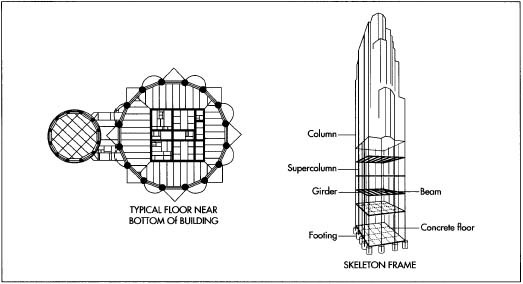The central support structure of a skyscraper is its steel skeleton. Metal beams are riveted end to end to form vertical columns. At each floor level, these vertical columns are connected to horizontal girder beams. Many buildings also have diagonal beams running between the girders, for extra structural support.
In this giant three-dimensional grid -- called the super structure -- all the weight in the building gets transferred directly to the vertical columns. This concentrates the downward force caused by gravity into the relatively small areas where the columns rest at the building's base. This concentrated force is then spread out in the substructure under the building. In a typical skyscraper substructure, each vertical column sits on a spread footing. The column rests directly on a cast-iron plate, which sits on top of a grillage. The grillage is basically a stack of horizontal steel beams, lined side-by-side in two or more layers (see diagram, below). The grillage rests on a thick concrete pad poured directly onto the hard clay under the ground. Once the steel is in place, the entire structure is covered with concrete.
In a typical skyscraper substructure, each vertical column sits on a spread footing. The column rests directly on a cast-iron plate, which sits on top of a grillage. The grillage is basically a stack of horizontal steel beams, lined side-by-side in two or more layers (see diagram, below). The grillage rests on a thick concrete pad poured directly onto the hard clay under the ground. Once the steel is in place, the entire structure is covered with concrete.Designing a low-rise building involves creating a structure that will support its own weight (called the dead load) and the weight of the people and furniture that it will contain (the live load). For a skyscraper, the sideways force of wind affects the structure more than the weight of the building and its contents. The designer must ensure that the building will not be toppled by a strong wind, and also that it will not sway enough to cause the occupants physical or emotional discomfort.

http://www.madehow.com/Volume-6/Skyscraper.html
http://science.howstuffworks.com/engineering/structural/skyscraper2.htm
http://www.english-online.at/art-architecture/skyscrapers/skyscrapers.htm
No comments:
Post a Comment